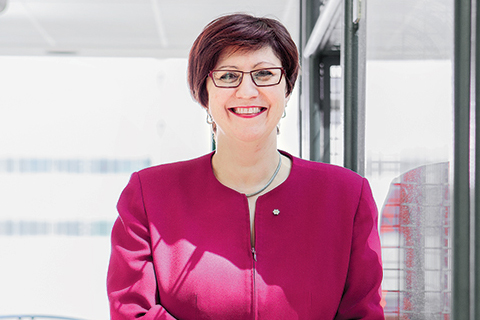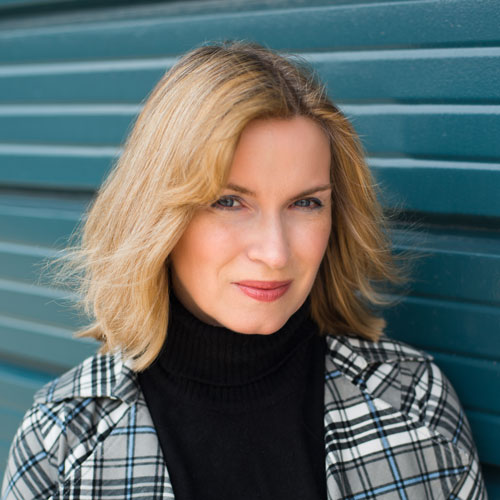The playrooms at Toronto’s Hospital for Sick Children glow with sun and light; they’re welcome oases for young patients facing the painful reality of disease and injury. But in 2004, the atmosphere wasn’t nearly as sunny for those running the venerable institution everyone knows as “Sick Kids.”
At the time, Canada’s largest children’s hospital was managing to maintain the superior standard of care that has always been its hallmark. But it was beset by difficulties, including a $13.5-million budget shortfall and the closure of a key surgical unit. A health-care ministry battered by recession was radically changing its service structure, while ordering all hospitals to balance their books. To top it off, Sick Kids had seen two CEOs – a chartered accountant, then a management consultant – resign in the space of only three years.
An aggrieved search committee knew someone had to come in and turn things around. Quickly, that someone was found. And she’d been right there with them, all along.
When Mary Jo Haddad (MHSc 1998) was growing up in Windsor, Ontario, she hardly aspired to run a hospital. But there was one thing she really did want to be. “I had a cousin staying with my family who was studying nursing,” recalls the bespectacled, soft-spoken 57-year-old. “She’d come home from the hospital, and tell all these interesting stories.”
Haddad’s father – an immigrant from Lebanon who owned a butcher shop – wasn’t sure nursing was a proper career choice for his eldest daughter. “He had the old-school vision of a nurse being someone who just emptied bedpans and changed bedsheets,” Haddad’s husband, Jim Forster, told the Globe and Mail in 2009. “He didn’t realize the modern role of the nurse as a critical partner in caregiving.”
So Haddad persisted, first earning a nursing diploma, then a bachelor’s degree in the field. She’d always loved kids, and, with five siblings, was a natural caregiver. Soon, she found herself working in the neonatal intensive-care unit at the Children’s Hospital of Michigan. For the next eight years, Haddad moved up the nursing ladder, ultimately becoming the hospital’s charge nurse of evening shifts.
“My nursing background definitely shaped my early success in health care,” she remembers, sitting in her office, which, like the hospital’s famously skylit atrium, is flooded with spring sunshine. “Compassion, empathy, building strong and healthy relationships. Those are all a fundamental part of what nurses do.”
Two people from that time stand out for her. One was her boss, a tough, no-nonsense nurse – also a nun – who pushed Haddad hard and sharpened her critical thinking and leadership skills. The other was a premature infant named Sheldon, “so tiny he weighed less than a pound and fit in the palm of her hand,” writes Richard Davis, who profiled Haddad in his book Intangibles of Leadership. In his instinctual fight to live, writes Davis, Sheldon was “the person who more than any other taught her the importance of courage and desire.”
Tragically, Sheldon didn’t win his fight; neither did many others. “I went to four funerals in three months,” Haddad says, recalling the days when childhood leukemia was a virtual death sentence (these days, the cure rate is 80 per cent). The work was consequently gruelling, but rewarding, too; Haddad most loved visiting families whose infants had survived life-threatening illnesses, imparting caregiving skills to them so they could rebuild lives that were very nearly shattered. Thus was born a lifelong commitment to children’s health.
In 1984, Haddad came to Sick Kids, first taking a job as assistant manager in the neonatal intensive-care unit. There was a ladder there, too, one she was eager to climb – from unit manager to chief nurse executive, to vice-president and chief operating officer, to her appointment in November 2004 as president and CEO. With the exception of one brief foray outside the hospital in 1999, she’s never been anywhere else. As she once admitted: “I have this place in my bones.”
***
Hospital administrators can come from virtually any background: law, business and even professional sports (former CEO Mike Strofolino was a well-known football player before becoming an accountant). Increasingly, though, hospital heads are being plucked from the ranks of clinical care. Physicians are now at the helm of many Toronto hospitals, with a handful from physiotherapy and nursing. To complement her clinical background, Haddad completed a master’s in health science administration at U of T in 1998, a program she describes as “a catalyst for enhanced leadership in my career.” It also demonstrated her ability to balance career and family. “The personal highlight of the two years was delivering my third child, Jonathan, while attending the program and not missing a day of class,” she recalls. “He joined me in the early weeks as an attentive learner – and believes he should be granted an honorary degree!”
Professor Linda McGillis Hall is an associate dean at U of T’s Lawrence S. Bloomberg Faculty of Nursing. She believes that a strong, driven nurse such as Haddad, with whom she worked some 20 years ago, is uniquely suited to perform as a top hospital executive. “Nurses are the ones who spend the time with patients,” says McGillis Hall. “They’re the ones who provide most of the care. So they know most about systems of health-care delivery and the basics of what’s needed to manage and drive results.”
Indeed, many early hospitals were founded by nurses – or other groups of capable women, such as social workers or nuns. Sick Kids itself was founded in 1875 by a group of female volunteers, led by philanthropist Elizabeth McMaster.
Caring for children is an extremely delicate matter, invariably involving a whole family instead of a mere individual. It could easily be said that nothing scares or touches us so much as the prospect of a grievously ill or dying child.
This may be why it’s common to hear extraordinary stories of nurses going the extra mile at Sick Kids. “They have really top-notch doctors there, but the hands-on care you get from nurses is just not comparable to any other hospital,” says one mother of a longtime cardiac patient. She recalls one nurse consoling her teenage daughter, who had to miss her senior prom; another brought freshly baked banana bread to her daughter, so she could taste a touch of home. The mother also witnessed a nurse taking pictures of a very sick little girl, dressed up for an outing to the Eaton Centre. “The nurses are on the front lines,” she continues. “That’s the care you really feel.”
So it’s perhaps fitting that Sick Kids be led by one of these thoughtful women – one with a background in critical care, who can make snap judgments when needed. But one who also embraces the “transformational” leadership model: collaborative, nurturing and developmental. What seems clear is that the mother of three is a fiercely proud proponent of caregiving, an activity our society often undervalues. However, the type of leadership women have often exhibited as mothers, teachers or nurses is now rapidly becoming not only fashionable but necessary – for male as well as female leaders.
Psychologist Daniel Goleman, whose work Haddad values, says that leadership is now in flux, largely because of information technology. “It used to be knowledge was power,” he said in a recent speech. “But now knowledge is shared instantly, globally and throughout organizations.” Patients, and their families, too, are much better informed than they used to be; increasingly, they want health-care providers to be partners instead of oracles. Succession planning is critical in the modern workplace, where people hold jobs for shorter periods. And fostering community spirit in a diverse environment such as Sick Kids is a must, as staff members hail from many different countries and all walks of life.
“Usually, the transformational leadership style shows better financial results and produces happier employees,” says Beatrix Dart, the associate dean of executive degree programs at the Rotman School of Management, “so it’s certainly preferred.” Dart describes the “transactional” leadership style as “I tell you what to do and you get paid for your job of doing it.”

The numbers attest to Haddad’s success as a transformational leader. Sick Kids is an especially expensive hospital to run, from a procedural point of view; the large majority of children undergoing procedures have to be anesthetized, and many devices (such as blood pressure cuffs or incubators) must be custom-designed for the tiniest of patients. And yet, through a series of innovations, Haddad has managed to raise annual revenues by a staggering $190 million. “She is,” says Catharine Whiteside, dean of U of T’s Faculty of Medicine, “an absolutely spectacular senior executive.”
How has she done it? In the main, you can point to Sick Kids International, which underscores the hospital’s longstanding commitment to treating children around the world. (Its famous “Herbie Fund” has provided assistance to more than 650 candidates for complex surgery from 102 countries.) Increasingly, global institutions in countries such as Ireland and India are paying for Sick Kids experts to travel to their countries, where they provide clinical help and teaching.
“How many countries are we affiliated with? I can’t even tell you the number,” Haddad says. Sick Kids International’s most prominent undertaking has been in Qatar, where it has set up an entire children’s hospital – winning the bid over several large American hospitals. Haddad thinks there’s a reason for that. “We’re helping to build capacity there,” she says. “We always do these things with an eye to teaching and knowledge translation,” instead of just providing equipment and staff. The aim is that the hospital will be, in the end, self-supporting.
Haddad has also benefited from solid donor relationships and a turnaround in the fortunes of Sick Kids’ longtime foundation, whose once-sluggish portfolio was revitalized by savvy investor Prem Watsa (the so-called “Warren Buffett of Canada”). Extra revenues have enabled her to realize what is perhaps her greatest dream for the hospital: construction of the 21-storey, $400-million Peter Gilgan Centre for Research and Learning, rising into the sky at the corner of Bay and Elm streets.
“Without her drive and leadership, the tower would never have been built,” says Whiteside. “That was a huge goal for her.” Research is central to Sick Kids; this is where Pablum was invented and where pediatric blood transfusions were pioneered. These days, Sick Kids is leading the way in genome research (the cystic fibrosis gene was identified here). However, researchers work in diffuse conditions.
At the hospital, there are basic scientists who work all day in labs; these are separate from the new breed of clinician-scientists, who also work with patients. Consequently, they may be missing out on each others’ discoveries.
“The premise is to mix and mingle scientists, so they can collaborate,” says Haddad. “We haven’t made it easy to do that, because currently they’re spread out in seven different buildings.” Scheduled to open in the fall of 2013, the centre will also provide educational opportunities for staff and trainees, and – with its large, sun-drenched windows, so characteristic of this hospital and few others – “bring research to the public.”
The biggest challenge Haddad has faced? Ensuring that attention gets paid to children’s health. With a rapidly aging population (by 2056, one in four Canadian adults will be senior citizens), that’s not been easy. And yet, Sick Kids tackles a huge range of diseases and health concerns. For example, 45 per cent of head-injury patients who visit Ontario emergency rooms are children. Obesity remains a critical problem in young people. Furthermore, “many diseases of adulthood are seeded in childhood,” says Haddad. “We know that from our research, and from kids’ responsiveness to targeted treatment, we can have a profound effect on adult life and the trajectory of disease.”
So, in addition to increasing revenues for her own hospital, Haddad knows that fighting for additional provincial investment in children’s health will be a continued battle for whoever succeeds her. “Really and truly, the biggest challenge for the CEO of a children’s hospital is going to be the children’s agenda, in a world where we’re so consumed with the ill health of the aging population; and where most people believe – and expect – children to be healthy,” she says.
That successor will soon be taking the reins: Haddad is scheduled to retire at the end of 2013. No longer will she have to make the long drive into Toronto from outlying Oakville to be at her desk each morning at 7:30. Her children are now young adults, and husband Jim (a former sales and marketing executive) has retired as well. “I’ll take some time off ,” she says, “though I can’t see myself not doing anything.”
It’s one of the few times Haddad uses the word “I” when speaking of her time at the hospital. Otherwise, she is eager to portray all her initiatives – from international partnerships, to advocacy, to the Peter Gilgan Research and Learning Centre – as team efforts.
“She’s always encouraging people to not get caught up in feeling they have to do something alone,” says Pam Hubley, chief of nursing, who considers Haddad her mentor. “Her feeling is that we can get so much more done if we’re all working together toward the same end; we’ll have a lot more innovation if we all bring our ideas to the table and work together.”
Mary Jo Haddad leaves a team capable of carrying on without her. And like the best of transformational leaders, she wouldn’t have it any other way.
Cynthia Macdonald (BA 1986 St. Michael’s) is a writer in Toronto.
Recent Posts
For Greener Buildings, We Need to Rethink How We Construct Them
To meet its pledge to be carbon neutral by 2050, Canada needs to cut emissions from the construction industry. Architecture prof Kelly Doran has ideas
U of T’s 197th Birthday Quiz
Test your knowledge of all things U of T in honour of the university’s 197th anniversary on March 15!
Are Cold Plunges Good for You?
Research suggests they are, in three ways





